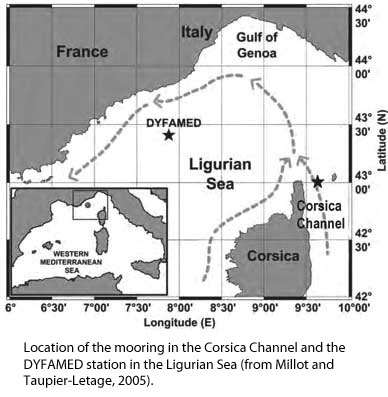 The second JERICO TNA experiment (www.jerico-fp7.eu) started on Tuesday November 20th, 2012, with the implementation of automatic Dissolved Oxygen (DO) measurements in the Corsica Channel, Ligurian Sea, Western Mediterranean. The experiment is planned to last for twelve months under the aegis of JERICO TNA and then continue for at least other six months as a collaboration of the Institute of Marine Sciences of the National Research Council of Italy (ISMAR CNR), the Observatoire Oceanographique de Villefranche/Mer of the French National Center for Scientific Research (CNRS/OBS-VLFR) and the Mediterranean Institute of Oceanography (MIO).
The second JERICO TNA experiment (www.jerico-fp7.eu) started on Tuesday November 20th, 2012, with the implementation of automatic Dissolved Oxygen (DO) measurements in the Corsica Channel, Ligurian Sea, Western Mediterranean. The experiment is planned to last for twelve months under the aegis of JERICO TNA and then continue for at least other six months as a collaboration of the Institute of Marine Sciences of the National Research Council of Italy (ISMAR CNR), the Observatoire Oceanographique de Villefranche/Mer of the French National Center for Scientific Research (CNRS/OBS-VLFR) and the Mediterranean Institute of Oceanography (MIO).
The experiment is part of a research proposed by CNRS/OBS-VLFR (P.I. Dr Laurent Coppola) to the First TNA call of JERICO. The purpose of the research is integrating the dissolved oxygen concentration in the long term time series data in the Ligurian basin to track the water mass variability, the impact of the water mass change on the oxygen content and to estimate the time lag between the eastern and the western part of the Ligurian Sea. The Levantine Intermediate Water (LIW) is the warmest and saltiest water resulting from the dense water formation processes occurring in the Mediterranean Sea. This water mass is formed in the Levantine basin and circulates from the Eastern basin to the Western basin through the Sicilian Strait. In the Northwestern basin, the Corsica Channel is a strategic site where a branch of the LIW is passing through before reaching the DYFAMED site (cyclonic circulation) and the area of dense water formation.
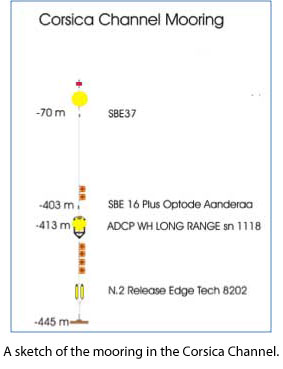 From previous time series data, a time lag has been observed in terms of T-S change in the LIW level. To solve this issue, regular and long term oxygen measurements might give a good opportunity to understand and to estimate accurately this time lag. This also gives the possibility to quantify the variability versus anomalies of the LIW property due to the climate change already observed in the Mediterranean Sea. The DYFAMED site (DYF, 2350 m depth), in the western part, and the CORSICA Channel (CC, 445 m depth), in the eastern part, are permanently monitored since 1988 and 1985 respectively to observe the water masses evolution and more specifically the shift of the LIW properties due to the climate change.
From previous time series data, a time lag has been observed in terms of T-S change in the LIW level. To solve this issue, regular and long term oxygen measurements might give a good opportunity to understand and to estimate accurately this time lag. This also gives the possibility to quantify the variability versus anomalies of the LIW property due to the climate change already observed in the Mediterranean Sea. The DYFAMED site (DYF, 2350 m depth), in the western part, and the CORSICA Channel (CC, 445 m depth), in the eastern part, are permanently monitored since 1988 and 1985 respectively to observe the water masses evolution and more specifically the shift of the LIW properties due to the climate change.
These observations are done through fixed moorings regularly maintained to record temperature, salinity and currents data. Since 2005 and 2009, the CC and DYF moorings are equipped with precise Seabird SBE37 sensors (0.001°C). Both moorings are maintained every year through annual/semiannual scientific cruises in order to collect T-S data, to clean and to calibrate the sensors and to repair the mooring line.
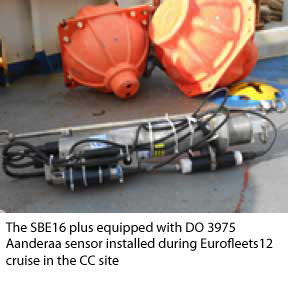 In summer 2012, the DYFAMED mooring located in the Ligurian Sea between Nice and Calvi has been equipped with two DO sensors (optode 4330F) at 400 m and 2000 m depth (MOOSE-GE cruise). The objective of the TNA activity was to complete the oxygen observation in the Ligurian Sea by implementing a DO sensor on the CC mooring at the core of the LIW water mass (400 m depth). This was done during a maintenance cruise (EUROFLEETS12), performed in November 2012 with the research vessel URANIA of CNR, installing an optical dissolved oxygen sensor (OPTODE 3975 Aanderaa) on the underwater station at 400 m depth.
In summer 2012, the DYFAMED mooring located in the Ligurian Sea between Nice and Calvi has been equipped with two DO sensors (optode 4330F) at 400 m and 2000 m depth (MOOSE-GE cruise). The objective of the TNA activity was to complete the oxygen observation in the Ligurian Sea by implementing a DO sensor on the CC mooring at the core of the LIW water mass (400 m depth). This was done during a maintenance cruise (EUROFLEETS12), performed in November 2012 with the research vessel URANIA of CNR, installing an optical dissolved oxygen sensor (OPTODE 3975 Aanderaa) on the underwater station at 400 m depth.
In summer 2013 the underwater station will be maintained again and a second sensor (OPTODE 4330 Aanderaa) will be installed at the same position for simultaneous measurements and comparison.
The Oxygen optode is designed to measure absolute oxygen concentration and % saturation. The optode sensor fits to the long term monitoring, as the data drift is very low and the data accuracy higher than other chemical sensor. The optode 3975 Aanderaa is installed on a SBE16 plus probe equipped with alkaline battery and will record the dissolved oxygen concentration every 30 min. This sensor has been calibrated during the cruise with Winkler titration. The DO sensor will be deployed for 2 periods of 6 months to be consistent with the DYF site (where data are collected every 12 months), and the second period will run together the optode 4330 Aanderaa. The optode 4330 has a time response faster than optode 3975 (less than 25s) with a better accuracy and precision (<8 μmol/l and <1 μmol/l, respectively).
Data will be recovered at each mooring maintenance, when dissolved oxygen concentrations will be also measured by Winkler titration in order to calibrate the automatic DO measurements. This operation is essential in order to check the quality of the DO data acquired by the sensor. After validation, DO data will be analysed along with other parameters measured in the site after each period.
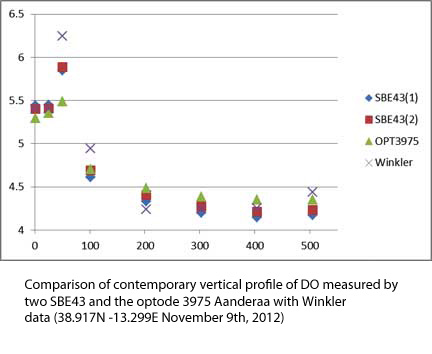
During the cruise, additional measurements were carried out, which will be available for completing the study. Those are physical (CTD stations, vessel mounted ADCP, lowered ADCP profiles) and chemical (dissolved oxygen, dissolved inorganic nutrients) measurements.
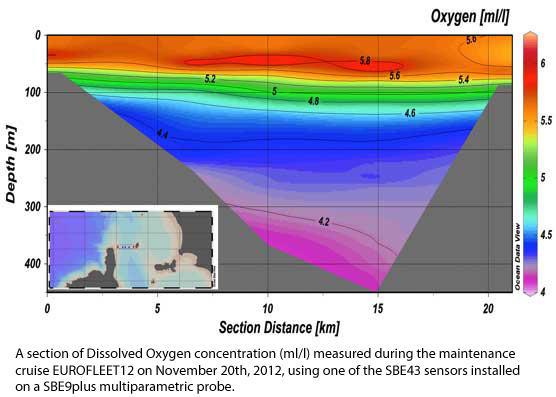
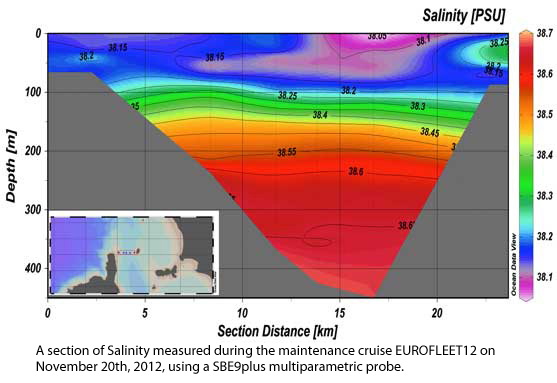
References
Millot, C. and Taupier-Letage, I., 2005. Circulation in the Mediterranean Sea. The Handbook ofEnvironmental Chemistry, K, 29 – 66, doi:10.1007/b107143
CC: http://www.jerico-fp7.eu/images/tna/fixed-platforms/fixed_platforms_mplc_cnr.pdf
DYF: http://www.eurosites.info/dyfamed.php
by Katrin Schroeder(1), Laurent Coppola(2), Mireno Borghini(1), Dominique Lefevre(3), Stefania Sparnocchia(1)
(1)ISMAR CNR, (2)Observatoire Oceanographique de Villefranche/Mer, (3)Mediterranean Institute of Oceanography
